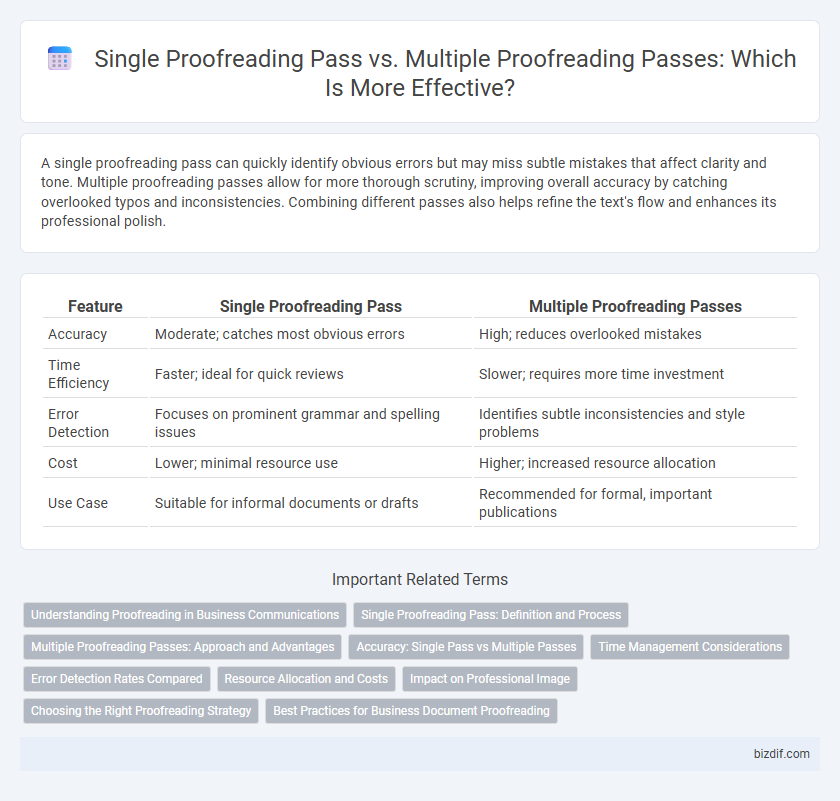A single proofreading pass can quickly identify obvious errors but may miss subtle mistakes that affect clarity and tone. Multiple proofreading passes allow for more thorough scrutiny, improving overall accuracy by catching overlooked typos and inconsistencies. Combining different passes also helps refine the text's flow and enhances its professional polish.
Table of Comparison
| Feature | Single Proofreading Pass | Multiple Proofreading Passes |
|---|---|---|
| Accuracy | Moderate; catches most obvious errors | High; reduces overlooked mistakes |
| Time Efficiency | Faster; ideal for quick reviews | Slower; requires more time investment |
| Error Detection | Focuses on prominent grammar and spelling issues | Identifies subtle inconsistencies and style problems |
| Cost | Lower; minimal resource use | Higher; increased resource allocation |
| Use Case | Suitable for informal documents or drafts | Recommended for formal, important publications |
Understanding Proofreading in Business Communications
Single proofreading pass helps identify most surface-level errors and improve clarity in business communications quickly, but may overlook deeper issues such as tone consistency and nuanced context. Multiple proofreading passes enable comprehensive error detection, refining grammar, style, and brand voice alignment for professional and persuasive messaging. Effective business communication requires balancing timely delivery with the thoroughness multiple passes provide to enhance credibility and stakeholder trust.
Single Proofreading Pass: Definition and Process
A single proofreading pass involves reviewing a written document once to detect and correct errors in grammar, punctuation, spelling, and formatting. This process requires intense concentration and a systematic approach to ensure all surface-level mistakes are identified without delving into content restructuring or deeper editing. While time-efficient, a single proofreading pass may miss subtle or complex errors that multiple passes could catch, affecting overall accuracy and quality.
Multiple Proofreading Passes: Approach and Advantages
Multiple proofreading passes involve reviewing the text several times, each with a distinct focus such as grammar, punctuation, and consistency, which significantly enhances error detection and correction accuracy. This approach reduces the risk of overlooking mistakes that might be missed in a single pass, ensuring a higher quality and more polished final document. Employing multiple passes improves clarity, coherence, and overall readability, benefiting academic, professional, and creative writing projects.
Accuracy: Single Pass vs Multiple Passes
A single proofreading pass may miss subtle errors, reducing overall accuracy, while multiple proofreading passes increase error detection by allowing fresh perspectives with each review. Studies show that multiple passes improve accuracy rates by up to 30%, especially for complex or technical documents. Accuracy gains from multiple proofreading rounds justify the additional time invested, ensuring higher-quality, error-free content.
Time Management Considerations
Single proofreading pass can save time in fast-paced projects but may increase the risk of missing errors, impacting overall quality. Multiple proofreading passes allow thorough error detection and improved accuracy but require more time allocation and scheduling flexibility. Effective time management balances project deadlines with the need for meticulous review to ensure optimal content quality.
Error Detection Rates Compared
Single proofreading passes typically detect around 50-60% of errors, while multiple proofreading passes increase detection rates significantly, reaching up to 90-95%. Each additional pass allows for catching different error types, such as grammatical mistakes, punctuation errors, and stylistic inconsistencies. Studies show that multiple passes reduce the risk of overlooked errors, enhancing overall text accuracy and quality.
Resource Allocation and Costs
Single proofreading pass efficiently allocates resources by concentrating efforts on one comprehensive review, reducing time and labor expenses. Multiple proofreading passes, while potentially improving accuracy, increase overall costs due to repeated allocation of human and technological resources. Balancing the trade-off between resource expenditure and error detection is essential for optimizing proofreading budgets.
Impact on Professional Image
A single proofreading pass reduces errors but may miss subtle mistakes, potentially undermining a professional image due to overlooked typos or inconsistencies. Multiple proofreading passes enhance accuracy by catching nuanced errors, resulting in polished documents that reinforce credibility and attention to detail. Consistently employing thorough proofreading practices strengthens professional reputation and fosters trust with clients and colleagues.
Choosing the Right Proofreading Strategy
Selecting the right proofreading strategy depends on the document's complexity and required accuracy. Single proofreading pass suits short or less technical texts, offering a quick, overall review for common errors. Multiple proofreading passes enhance precision by allowing focused corrections on grammar, style, and factual accuracy in successive rounds, ideal for critical or lengthy content.
Best Practices for Business Document Proofreading
Performing multiple proofreading passes enhances error detection and ensures clarity in business documents, addressing grammar, formatting, and content consistency separately for improved accuracy. A single proofreading pass risks overlooking subtle mistakes that can affect professionalism and reader comprehension. Best practices involve dividing the process into distinct reviews focused on different error types to optimize document quality and credibility.
Single Proofreading Pass vs Multiple Proofreading Passes Infographic

 bizdif.com
bizdif.com